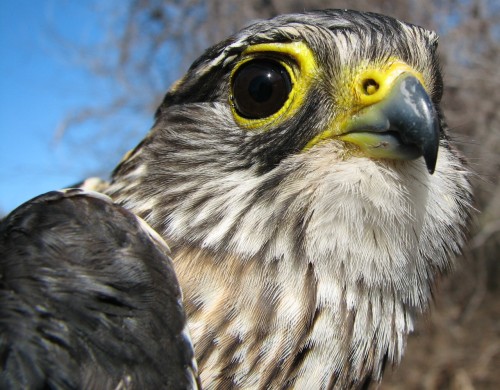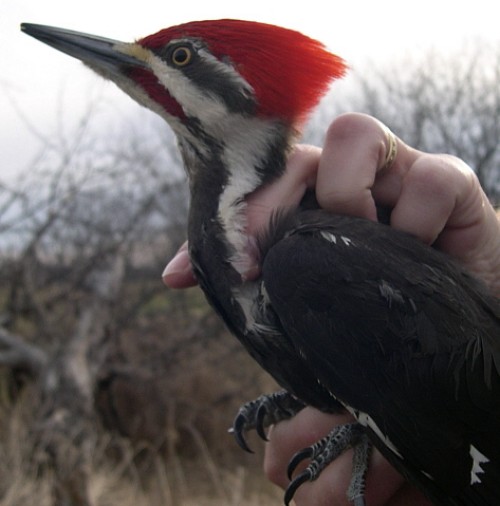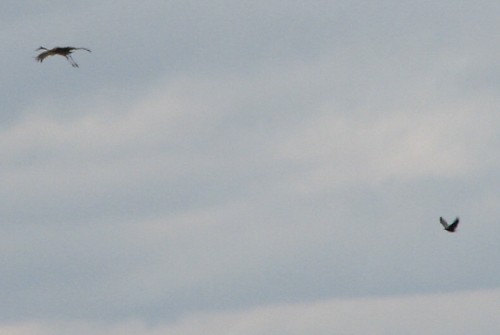|
McGILL BIRD OBSERVATORY |
|||||||||||||||||||||||||||||||||||||||||||||||||||||||||||||||||||
Welcome
to the McGill Bird Observatory weekly report.
Click here for a complete listing of our archives.
Banders-in-charge:
Barbara Frei, Lance Laviolette Notes: Week 4 was the first week of banding for spring 2007! Although the nets were fairly quiet – as expected for early spring – it was an exciting week nonetheless. Banding took place on 6 out of the 7 days – with our guest BIC Lance Laviolette banding on one of them. Week 4 was much changed from our previous weeks in that it actually felt as if spring (sometimes even summer!) had finally arrived; in fact the temperatures soared from the below freezing we experienced the weeks before to over 20°C. The springtime was felt by all, as bird, amphibian, reptile, and mammal activity increased. In our ponds we observed Muskrats and Painted Turtles, and we were greeted every morning with a chorus (sometimes almost deafening!) of Spring Peepers, Wood Frogs and Leopard Frogs. We had several highlights this week, with 22 new species observed and 13 species banded for the first time this year. The excellent species diversity this week brought the season total to 71 species observed - exactly where it was at this point in 2006! The banding total remains much lower, but that is to be expected as we decided that we decided not to band during the first three weeks this year as the mornings are often still too cold during that period, and it will be easier to maintain a consistent level of effort from year to year if we start somewhat later. The decision was made easier by the fact that 2006 proved to us that few birds are on the move during those first few cool weeks - we banded an average of fewer than 30 per week, which is far below MBO's usual standards. Thursday morning the skies turned white as several giant waves of Snow Geese migrated passed. Our heads craned back, we attempted to count the numbers and reached a verdict of at least 4500 geese passing us in mere minutes on their sojourn northwards. Later that morning our heads turned skywards again and our faces were wreathed with smiles as we happily greeted the first of the Tree Swallows to revisit our fields. While walking down the D-nets and admiring the acrobatics of the swallows above us, we were suddenly startled as a dark blur buzzed right before our faces and a second later heard a resounding crash near the A nets. Five minutes later we had in our hands MBO’s first Merlin, a gorgeous slate blue after-second-year male. Sunday operations were run by our guest BIC – Lance Laviolette – and was a unique day for him, as he banded his first Pileated Woodpecker, only the 3rd to be banded at MBO (the last one coming just slightly earlier in spring last year). An impressively large bird (with an especially large bill!) is an awe-striking sight from a nearby tree and even more so in the hand – but under Lance’s expert hand the woodpecker was soon banded and sent back on his way. Also on Sunday we had the season's first sightings of a soaring Rough-legged Hawk and a Wilson's Snipe.
A rather summery Monday brought a total of 8 new species for spring 2007: Blue-winged Teal, Osprey, Broad-winged Hawk, Winter Wren, Ruby-crowned Kinglet, Myrtle Warbler, Savannah Sparrow and Rusty Blackbird. The chuckling call of the Ruby-crowned Kinglets were soon heard from every corner and there was no surprise that they as well as their smaller cousins, the Golden-crowned Kinglet, found their way into the nets. Our week ended with no less excitement. Tree Swallow numbers grew to 16 individuals, and favourite nest boxes were marked by pairs of swallows perched on the roofs. Both Tree Swallows and Swamp Sparrows were newly banded species on Tuesday. The trill of the Chipping Sparrow and musical song of the House Finch added these two species to our spring list. Tuesday was a very memorable day for MBO, as we added two new species to our overall list, thanks to the keen eyes and ears of our volunteers, especially Betsy McFarlane and Andrew Plimer. Along with the Savannah Sparrows calling from the grassy field next to the station, a pair of Vesper Sparrows was spotted flitting amid the tangled hedge and grasses. Late in the morning, the unmistakable silhouette of a Sandhill Crane soared in the distance causing great excitement as it circled the area, apparently searching for a place to land. This increased our total of bird species seen at MBO to 183 species.
The top ten species banded are not very surprising – Red-winged Blackbirds, Song Sparrows, American Robins and Black-capped Chickadees are all actively establishing their territories in preparation for the summer breeding period. The numbers of American Tree Sparrows are dropping as they migrate further north to their breeding grounds. The Ruby-crowned Kinglets will most likely be in our top ten list for some weeks to come as we expect their numbers will increase with time. As our overall number of birds banded is still low – we have are less numerous species, such as the Downy Woodpecker and the Eastern Phoebe gracing our list. We also had a Phoebe that was banded last year return to our site and revisit our nets – it is always nice to see individuals successfully return to MBO after their southern journey. In total we had 13 individuals returning of 6 different species. Snow Geese top our list of species observed this week as a consequence of the large migration on Thursday. Other than this leap to the top position and a slight reshuffling of positions, no major changes have taken place in the top 10 observed species for the 4th week of spring. But with the warmer weather and hopefully some southerly winds – this will change in the coming weeks as the migrants flood our area on their way northwards. It is interesting to note that at this time last year, Northern Pintail, Brown-headed Cowbird, and Slate-coloured Junco were among the top 10 species observed, with a daily average of 12 to 24 individuals observed; however, the Snow Geese that have been so abundant lately were not around at all at this time last spring, and American Goldfinch and Black-capped Chickadee are also slightly more numerous currently than at this time in 2006.
|



